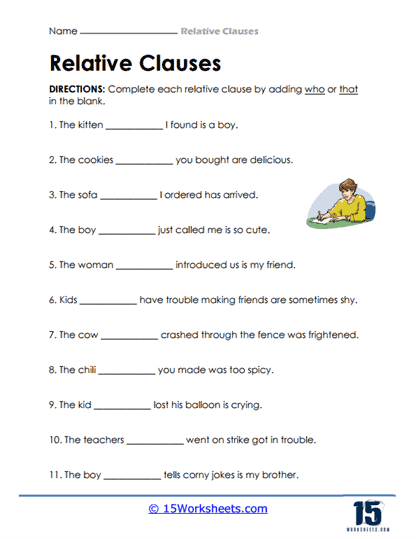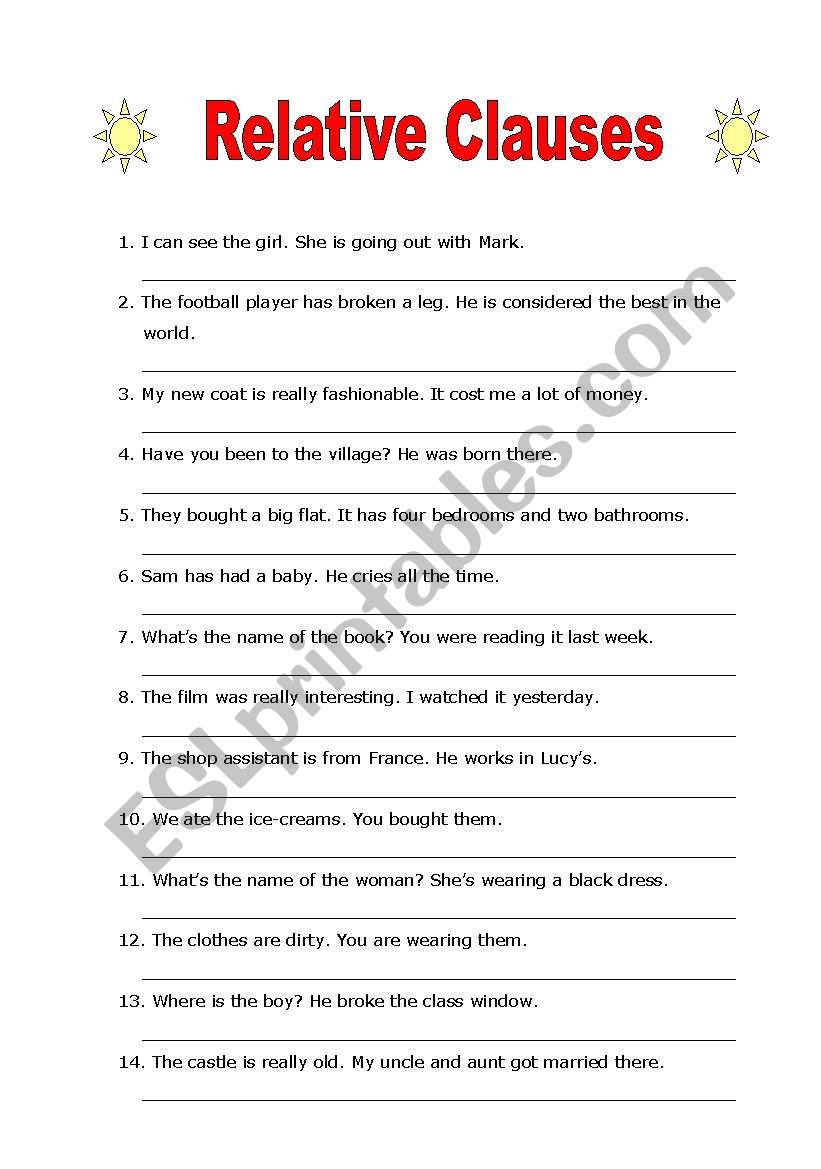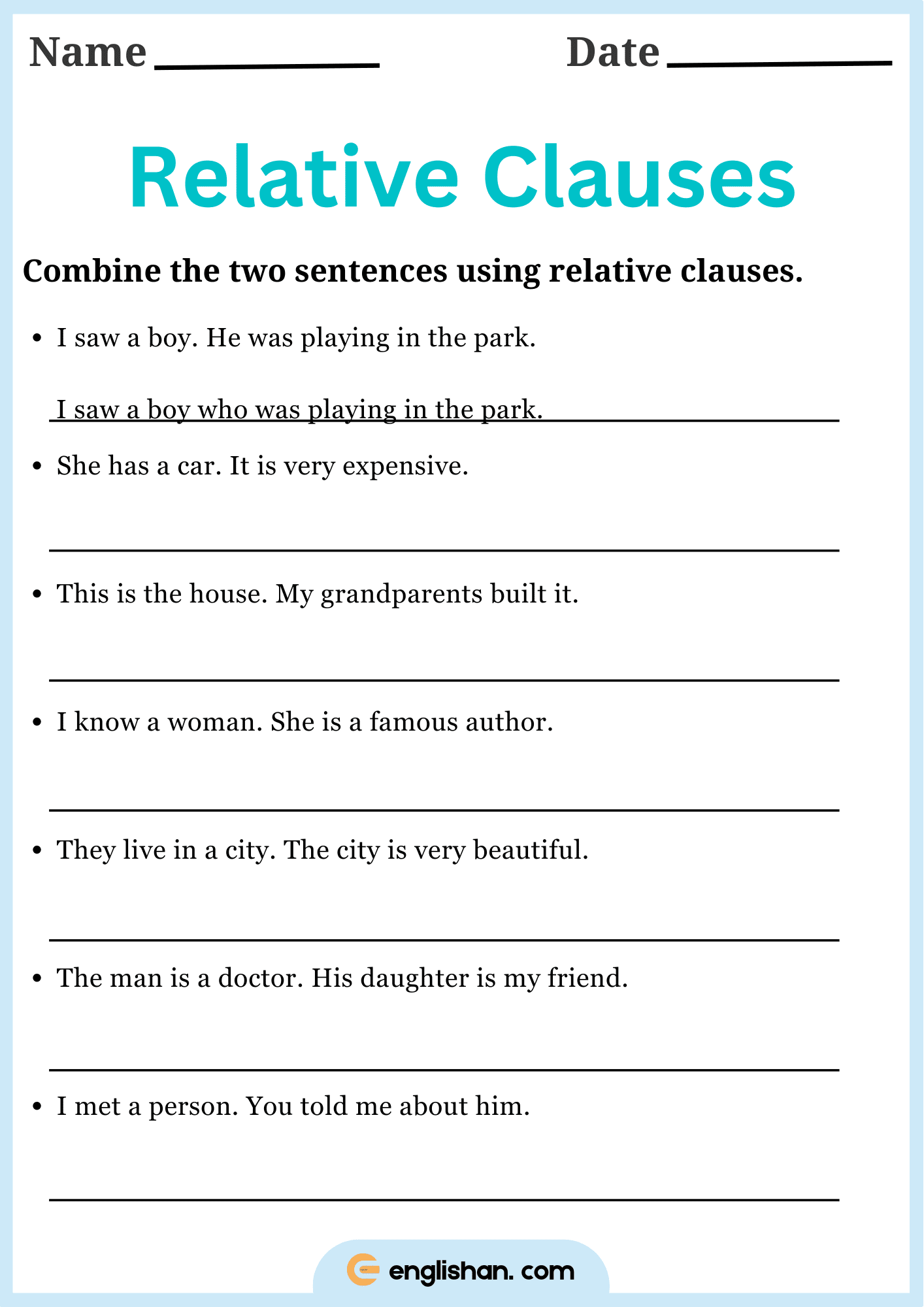
Mastering Grammar with Relative Clauses Worksheets: A Comprehensive Guide
In the intricate tapestry of the English language, relative clauses serve as vital threads, weaving together ideas and adding depth and precision to our communication. They allow us to combine sentences, provide essential or additional information about nouns, and avoid repetitive phrasing. However, for many learners, mastering these complex structures can be a significant hurdle. This is where well-designed and strategically implemented relative clauses worksheets become indispensable tools. This article will delve into the profound importance of relative clauses, explore the diverse types of worksheets available, highlight their benefits, and provide guidance on how to effectively integrate them into the learning process.
Understanding Relative Clauses: The Foundation
Before we explore the utility of relative clauses worksheets, it’s crucial to have a solid understanding of what relative clauses are. Also known as adjective clauses, these are dependent clauses that function like adjectives, modifying a noun or pronoun. They begin with a relative pronoun (who, whom, whose, which, that) or a relative adverb (where, when, why) and contain a subject and a verb.

Key characteristics:

- Dependent: They cannot stand alone as a complete sentence.
- Modify Nouns/Pronouns: They provide more information about a specific noun or pronoun in the main clause.
- Introduced by Relative Pronouns/Adverbs: These words connect the relative clause to the noun it modifies.



Types of Relative Clauses:
-

Restrictive (Essential) Relative Clauses: These clauses provide information that is essential to the meaning of the sentence. Without them, the sentence’s meaning would be unclear or change significantly. They are not set off by commas.
- Example: The student who answered all the questions correctly received an award. (We need to know which student received an award.)


-

Non-Restrictive (Non-Essential) Relative Clauses: These clauses provide additional, non-essential information. The sentence would still make sense without them. They are set off by commas.
- Example: My sister, who lives in London, is visiting next week. (The fact that she lives in London is extra information; I only have one sister.)
Understanding these fundamental concepts is the first step, but true mastery comes through consistent practice, which is precisely what relative clauses worksheets are designed to provide.
The Indispensable Role of Relative Clauses Worksheets
Grammar rules, while logical, often feel abstract to learners. Relative clauses worksheets bridge this gap by transforming abstract rules into concrete exercises. They offer a structured environment for students to apply their knowledge, identify patterns, and solidify their understanding. Without targeted practice, students might grasp the concept intellectually but struggle to produce grammatically correct sentences spontaneously.
Worksheets serve multiple critical functions:
- Reinforcement: They reiterate lessons learned in class, helping information move from short-term to long-term memory.
- Application: They provide opportunities to apply theoretical knowledge to practical sentence construction.
- Diagnostic Tools: Teachers can use completed worksheets to pinpoint specific areas where students are struggling, allowing for targeted intervention.
- Self-Paced Learning: Students can work through exercises at their own speed, reviewing concepts as needed.
Types of Effective Relative Clauses Worksheets
A comprehensive approach to teaching relative clauses should incorporate a variety of worksheet types, each targeting a different aspect of understanding and application.
-
Identification and Underlining Worksheets:
- Purpose: To help students recognize relative clauses and their components within existing sentences.
- Activity: Students read sentences and underline the relative clause, circle the relative pronoun, and/or identify the noun it modifies.
- Example Exercise: Underline the relative clause in each sentence: "The book that I read yesterday was fascinating."
-
Combining Sentences Worksheets:
- Purpose: To teach students how relative clauses can combine simple sentences into more complex, coherent ones, avoiding repetition.
- Activity: Students are given two or more simple sentences and asked to combine them using a relative pronoun to form a single sentence with a relative clause.
- Example Exercise: Combine the following sentences: "She is a doctor. She works at the local hospital." (Combined: "She is a doctor who works at the local hospital.")
-
Filling in the Blanks (Pronoun Choice) Worksheets:
- Purpose: To practice selecting the correct relative pronoun (who, whom, whose, which, that) based on the context and the type of noun being modified.
- Activity: Sentences are provided with a blank where a relative pronoun should go. Students choose the most appropriate pronoun.
- Example Exercise: Complete the sentence with the correct relative pronoun: "The car, ___ was red, sped down the road." (Answer: which)
-
Comma Usage and Restrictive/Non-Restrictive Worksheets:
- Purpose: To differentiate between restrictive and non-restrictive clauses and correctly apply comma rules. This is often one of the most challenging aspects for learners.
- Activity: Students are given sentences and asked to add commas where necessary or to identify whether a given relative clause is restrictive or non-restrictive.
- Example Exercise: Add commas if needed: "My brother who lives in Canada is visiting." (Correct: "My brother, who lives in Canada, is visiting.")
-
Error Correction Worksheets:
- Purpose: To develop students’ editing skills and their ability to identify and correct common mistakes related to relative clauses.
- Activity: Sentences with grammatical errors (e.g., wrong pronoun, missing pronoun, incorrect comma usage) are provided for students to correct.
- Example Exercise: Correct the error: "The dog, that barked all night, kept me awake." (Correction: "The dog, which barked all night, kept me awake.")
-
Sentence Transformation and Reduction Worksheets:
- Purpose: To explore how relative clauses can be reduced to phrases (e.g., participle phrases) for more concise writing. This is an advanced skill.
- Activity: Students transform sentences containing relative clauses into more concise forms or vice-versa.
- Example Exercise: Reduce the clause: "The man who is standing by the window is my uncle." (Reduced: "The man standing by the window is my uncle.")
-
Creative Writing and Application Worksheets:
- Purpose: To encourage students to use relative clauses in their own original writing, fostering fluency and natural application.
- Activity: Prompts that require students to write paragraphs, short stories, or descriptions, explicitly instructing them to incorporate a certain number of restrictive and non-restrictive clauses.
- Example Exercise: Write a short paragraph describing your dream vacation, using at least three relative clauses.
Benefits of Incorporating Relative Clauses Worksheets into Learning
The advantages of using relative clauses worksheets extend beyond mere practice:
- Structured Practice: Worksheets provide a systematic way to reinforce learning, moving from basic identification to more complex application.
- Immediate Feedback: When coupled with answer keys, worksheets offer students immediate feedback on their understanding, allowing them to correct mistakes and learn from them instantly.
- Diagnostic Capabilities: For educators, analyzing common errors on worksheets can quickly pinpoint areas where the entire class or individual students need more instruction.
- Flexibility and Customization: Worksheets can be tailored to different proficiency levels, from beginner to advanced, ensuring that the content is always appropriately challenging.
- Increased Confidence: Successfully completing exercises builds students’ confidence in their grammatical abilities, encouraging them to take on more complex writing tasks.
- Preparation for Standardized Tests: Many standardized English proficiency tests include sections that assess knowledge of relative clauses, making worksheet practice invaluable.
- Enhances Reading Comprehension: Understanding how relative clauses modify nouns helps students better comprehend complex sentences encountered in reading.
Designing and Selecting High-Quality Relative Clauses Worksheets
Not all worksheets are created equal. When creating or selecting relative clauses worksheets, consider the following criteria for optimal effectiveness:
- Clear Instructions: Ambiguous instructions can hinder learning. Ensure that the task is clearly stated.
- Gradual Difficulty: Begin with simpler tasks (identification) and progressively move to more complex ones (combining sentences, error correction, creative writing).
- Varied Exercise Types: A mix of exercise formats keeps students engaged and targets different learning styles.
- Relevant and Engaging Content: Use sentences and scenarios that are relatable and interesting to the target audience. Abstract sentences can be demotivating.
- Ample Practice: Ensure there are enough exercises for students to genuinely internalize the concepts.
- Answer Keys: Crucial for self-correction and for teachers to quickly grade.
- Visual Appeal: A clean, uncluttered layout with clear formatting can make worksheets less intimidating and more user-friendly.
Common Challenges and How Relative Clauses Worksheets Help
Students frequently stumble on specific aspects of relative clauses. Worksheets can be specifically designed to address these common pitfalls:
- "Who" vs. "Whom": This is a perennial challenge. Worksheets can provide targeted exercises where students must decide between the subjective "who" and objective "whom," often by mentally substituting "he/him" or "she/her."
- "Which" vs. "That": Learners often misuse "that" for non-restrictive clauses or "which" for restrictive ones. Worksheets emphasizing comma usage and the essential vs. non-essential nature of the clause can clarify this.
- Comma Placement: Incorrect comma placement is a very common error. Worksheets that explicitly focus on restrictive vs. non-restrictive clauses, requiring students to add or remove commas, are vital.
- Omitting Relative Pronouns: Understanding when a relative pronoun can be omitted (when it functions as the object of the verb in the relative clause) is tricky. Worksheets can offer sentences where students identify if the pronoun can be removed without losing meaning.
- Identifying the Antecedent: Sometimes students struggle to identify which noun the relative clause is modifying, leading to misplaced modifiers. Worksheets can highlight the noun being modified.
By repeatedly exposing students to these specific challenges in a structured, practice-oriented format, relative clauses worksheets help solidify correct usage and reduce common errors.
Integrating Worksheets for Optimal Learning
Worksheets should not be used in isolation but as part of a broader instructional strategy:
- Pre-Assessment: Use a short worksheet before teaching the topic to gauge students’ prior knowledge and identify areas needing more focus.
- During Instruction: Integrate short, targeted exercises during or immediately after introducing a new concept (e.g., "now that we’ve discussed restrictive clauses, complete these five sentences").
- Post-Instruction (Homework/Review): Assign more comprehensive worksheets as homework to reinforce learning and allow for independent practice.
- Remediation: For students who are struggling, assign additional, simpler worksheets focusing on their specific areas of difficulty.
- Extension Activities: For advanced learners, provide challenging worksheets that involve sentence transformation or creative writing.
Conclusion
Relative clauses are a cornerstone of sophisticated English writing and speaking. They enable us to express complex ideas with clarity, conciseness, and elegance. While the concept itself can be challenging, the strategic use of relative clauses worksheets transforms a potentially daunting learning experience into a manageable and effective one. From basic identification to nuanced application in creative writing, these worksheets provide the essential practice, feedback, and reinforcement necessary for true grammatical mastery. Embracing the power of well-designed relative clauses worksheets is not just about teaching grammar rules; it’s about empowering learners to communicate with greater precision, confidence, and fluency, unlocking a higher level of linguistic proficiency.
